
Pompei is a city and comune in the Metropolitan City of Naples in Italy, home of the ancient Roman ruins Pompeii that are part of the UNESCO World Heritage Sites.
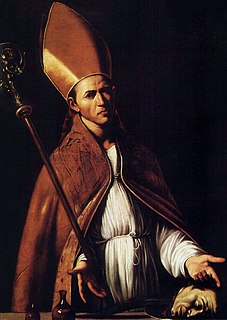
Januarius, also known as Januarius I of Benevento, was Bishop of Benevento and is a martyr and saint of the Catholic Church and the Eastern Orthodox Church. While no contemporary sources on his life are preserved, later sources and legends claim that he died during the Great Persecution which ended with Diocletian's retirement in 305.
Carlo Bononi was an Italian painter.

Santa Maria la Nova is a Renaissance style, now-deconsecrated, Roman Catholic church and monastery in central Naples. The church is located at the beginning of a side street directly across from the east side of the main post office, a few blocks south of the Church and Monastery of Santa Chiara. Today the adjacent monastery is a meeting site and hosts the Museo ARCA of modern religious art.
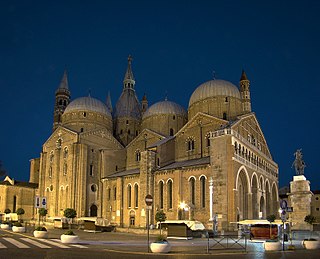
The Pontifical Basilica of Saint Anthony of Padua is a Roman Catholic church and minor basilica in Padua, Veneto, Northern Italy, dedicated to St. Anthony. Although the Basilica is visited as a place of pilgrimage by people from all over the world, it is not the titular cathedral of the city, a title belonging to the Cathedral-Basilica of St. Mary of Padua. The basilica is known locally as "il Santo". It is one of the eight international shrines recognized by the Holy See.

Giuseppe Bartolomeo Chiari, also known simply as Giuseppe Chiari, was an Italian painter of the late-Baroque period, active mostly in Rome.
Giuseppe Antonio Ghedini was an Italian painter of the Baroque period, mainly active in Ferrara.
Alfonso Rivarola was an Italian painter of the Baroque period, active mainly in Ferrara, where he was born. He is also known as il Chenda because of an inheritance he received from someone with that name.

Antonio Randa was an Italian painter of the classicist period, active in Ferrara, Modena, Rovigo, Florence, Comacchio and his native Bologna.
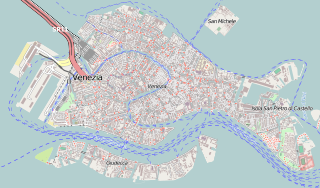
Santa Maria della Fava, also originally known as Santa Maria della Consolazione, is an ancient Roman Catholic church in the sestiere of Castello in Venice, Italy.
Domenico Mona (1550–1602) was an Italian painter of the late-Renaissance period, born in Ferrara.
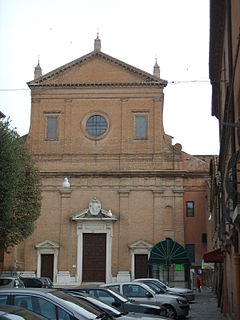
The Church of the Gesù of Ferrara is a Roman Catholic church, erected by the Jesuit order, located on piazzetta Torquato Tasso in Via Borgoleoni #56 in Ferrara, Region of Emilia-Romagna, Italy

The Church of the Theatines (Teatini), also known as Santa Maria della Pietà is a Roman Catholic, Baroque-style church and monastery located on Corso della Giovecca, in central Ferrara, region of Emilia-Romagna, Italy.
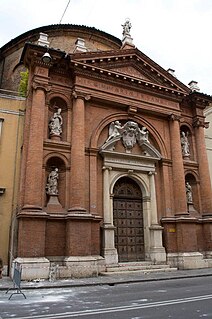
San Carlo Borromeo is a Baroque, Roman Catholic church located on Corso Giovecca #191, a block east of the Castello Estense in Ferrara, region of Emilia-Romagna, Italy.

San Giuliano is a small Gothic-style, Roman Catholic church located on the Piazzetta delle Castello on the southwest corner of the Castello Estense in Ferrara, region of Emilia-Romagna, Italy.

Ferrara Charterhouse, of which the present Church of San Cristoforo alla Certosa was previously the monastic church, is a former charterhouse or Carthusian monastery built in Renaissance style, located on Piazza Borso 50 in Ferrara, Region of Emilia-Romagna, Italy. The monastery was suppressed in the time of Napoleon, but the church was reconsecrated in 1813 and remains in use. The site also accommodates a large municipal cemetery, which was established in 1813.
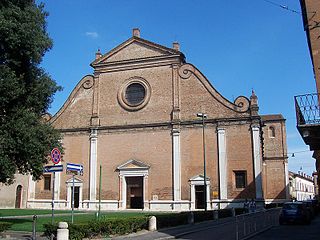
San Francesco is a late-Renaissance, Roman Catholic minor basilica church located on via Terranuova in Ferrara, region of Emilia-Romagna, Italy.
Santa Chiara also known as the Santuario Madonna della Misericordia or Sanctuary of the Mater Misericordia is a Baroque-style Roman Catholic church located in via Santa Chiara #28 in Rimini, Italy. The church is best known for housing a venerated icon of the Madonna that has putatively moved its eyes for many believers.

The Church of Saint Dominic is a church in Palermo, Sicily, southern Italy. It is located in Piazza San Domenico, in the quarter of La Loggia, within the historic centre of the city. The church hosts the burials of many figures of Sicilian history and culture. For this reason it is known as the "Pantheon of illustrious Sicilians".


















